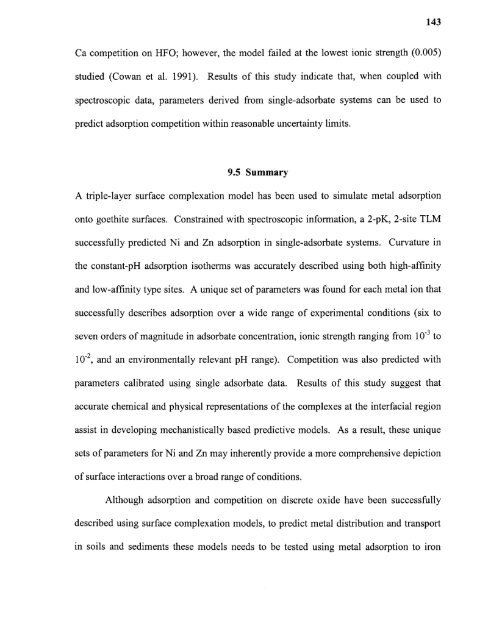Heavy metal adsorption on iron oxide and iron oxide-coated silica ...
Heavy metal adsorption on iron oxide and iron oxide-coated silica ...
Heavy metal adsorption on iron oxide and iron oxide-coated silica ...
You also want an ePaper? Increase the reach of your titles
YUMPU automatically turns print PDFs into web optimized ePapers that Google loves.
143Ca competiti<strong>on</strong> <strong>on</strong> HFO; however, the model failed at the lowest i<strong>on</strong>ic strength (0.005)studied (Cowan et al. 1991). Results of this study indicate that, when coupled withspectroscopic data, parameters derived from single-adsorbate systems can be used topredict <str<strong>on</strong>g>adsorpti<strong>on</strong></str<strong>on</strong>g> competiti<strong>on</strong> within reas<strong>on</strong>able uncertainty limits.9.5 SummaryA triple-layer surface complexati<strong>on</strong> model has been used to simulate <str<strong>on</strong>g>metal</str<strong>on</strong>g> <str<strong>on</strong>g>adsorpti<strong>on</strong></str<strong>on</strong>g><strong>on</strong>to goethite surfaces. C<strong>on</strong>strained with spectroscopic informati<strong>on</strong>, a 2-pK, 2-site TLMsuccessfully predicted Ni <strong>and</strong> Zn <str<strong>on</strong>g>adsorpti<strong>on</strong></str<strong>on</strong>g> in single-adsorbate systems. Curvature inthe c<strong>on</strong>stant-pH <str<strong>on</strong>g>adsorpti<strong>on</strong></str<strong>on</strong>g> isotherms was accurately described using both high-affinity<strong>and</strong> low-affinity type sites. A unique set of parameters was found for each <str<strong>on</strong>g>metal</str<strong>on</strong>g> i<strong>on</strong> thatsuccessfully describes <str<strong>on</strong>g>adsorpti<strong>on</strong></str<strong>on</strong>g> over a wide range of experimental c<strong>on</strong>diti<strong>on</strong>s (six toseven orders of magnitude in adsorbate c<strong>on</strong>centrati<strong>on</strong>, i<strong>on</strong>ic strength ranging from 10 -3 to10-2, <strong>and</strong> an envir<strong>on</strong>mentally relevant pH range). Competiti<strong>on</strong> was also predicted withparameters calibrated using single adsorbate data. Results of this study suggest thataccurate chemical <strong>and</strong> physical representati<strong>on</strong>s of the complexes at the interfacial regi<strong>on</strong>assist in developing mechanistically based predictive models. As a result, these uniquesets of parameters for Ni <strong>and</strong> Zn may inherently provide a more comprehensive depicti<strong>on</strong>of surface interacti<strong>on</strong>s over a broad range of c<strong>on</strong>diti<strong>on</strong>s.Although <str<strong>on</strong>g>adsorpti<strong>on</strong></str<strong>on</strong>g> <strong>and</strong> competiti<strong>on</strong> <strong>on</strong> discrete <strong>oxide</strong> have been successfullydescribed using surface complexati<strong>on</strong> models, to predict <str<strong>on</strong>g>metal</str<strong>on</strong>g> distributi<strong>on</strong> <strong>and</strong> transportin soils <strong>and</strong> sediments these models needs to be tested using <str<strong>on</strong>g>metal</str<strong>on</strong>g> <str<strong>on</strong>g>adsorpti<strong>on</strong></str<strong>on</strong>g> to ir<strong>on</strong>
















